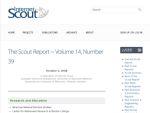After its first half-century, NASA celebrates and considers the future of its work
Two halves of NASA merge at half-century
http://www.msnbc.msn.com/id/26948872/
NASA at 50: Johnson Space Center being put to the test
http://www.chron.com/disp/story.mpl/headline/metro/6028850.html
50 Years in Space: NASA's Roadmap to 2058
http://www.space.com/news/081001-nasa50-road-ahead.html
The Hubble Space Telescope [Real Player, Macromedia Flash Player]
http://hubble.nasa.gov/
NASA Human Space Flight [Macromedia Flash Player, pdf]
http://spaceflight.nasa.gov/home/index.html
For fifty years, the work of the National Aeronautics and Space Administration (NASA) has fascinated children and adults both here in the United States and around the world. NASA officially opened its doors for business on October 1, 1958 and since that time they have sponsored hundreds of research missions that made household names of people like Alan Shepard, John Glenn, Neil Armstrong, and Buzz Aldrin. In recent years, the agency has weathered a number of criticisms, including some pointed critiques of the space shuttle program. One of the current programs that NASA is working on involves bringing robotic and human exploration together, rather than keeping them separated, which has been the practice for most of their history. Currently, NASA has a number of long-range plans to fix the Hubble Space Telescope, finish the international space station, and also return to the moon. Of course, one long-standing question that remains unanswered (and also quite controversial) is whether or not involving humans in spaceflight at all is worth the risk and expense. In a recent interview, physicist Robert Park remarked that manned spaceflight is an "old-fashioned way" to do things. In response, NASA administrator Michael Griffin noted, "Human spaceflight is about expanding the range of human action. And I think that matters."
The first link will take users to a piece from this Wednesday's Voice of America that discusses both the past accomplishments of NASA and their future challenges. The second link will whisk users away to a thoughtful piece by MSNBC's Alan Boyle on NASA's attempts to bring together the work of both robots and humans for future ventures and missions. The third link will take visitors to an article from this Monday's Houston Chronicle on the future of the Johnson Space Center, which is more commonly known to millions around the world as "Mission Control". Moving on, the fourth link leads to a fine piece from aerospace consultant Jim Banke on what can be expected from NASA in their next fifty years. The fifth link leads to the homepage of the Hubble Space Telescope. Here visitors can read about this tremendous piece of technology, view images, and also learn about its future missions. Finally, the last link leads to NASA's Human Space Flight website, where visitors can learn about future voyages to the moon and Mars.
Alternate Title
Voice of America: NASA, Probing the Solar System for 50 Years
Archived Scout Publication URL
Scout Publication
Creator
Publisher
Classification
Data Type
Required Software
Language
Date of Scout Publication
October 3rd, 2008
Resource URL Clicks
2
Internal
Cumulative Rating
0
Resources




Comments